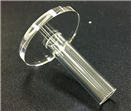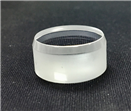

Time:2024-01-30
sapphire crystalIt has a wide range of applications, such as practical substrate materials for GaN blue-green semiconductor diodes, ideal window materials for high-power lasers, and laser substrate materials. Temperature gradient method and bubble method can be used for production, such as 80 kg, 120 kg, and 150 kg.
During the growth process of sapphire, stress is inevitably generated inside the crystal. Especially for sapphire crystal rods, additional processing stress will be introduced after the digging process, and stressed sapphire ingots may experience problems such as large arc curvature and low cutting accuracy during cutting. These issues may increase the stress on the cutting surface of the chip, resulting in greater warping and arching of the chip after cutting. In addition, after conventional annealing treatment (around 1400 ℃), the stress inside the chip cannot be released. Therefore, during the subsequent grinding and chamfering processes, chips are prone to problems such as edge breakage, cracks, warping, and astigmatism, which will further reduce yield. Therefore, in order to improve the yield of chip processing, it is necessary to eliminate internal stress in a timely manner. In addition, in growth furnaces using tungsten cages as heating elements, tungsten atoms (W) and a small amount of molybdenum atoms (Mo) may randomly enter the melt through solid-state diffusion, permeation, and other forms.

The sapphire glass grown by temperature gradient method (TGT method) will be placed in a medium high temperature oxidation atmosphere (1600 ℃ air atmosphere) and a high temperature reduction atmosphere (1900 ℃ hydrogen atmosphere) for 120 hours. After the "two-step" annealing process of stress relief and color removal, the crystal becomes colorless and transparent. After testing, the integrity and optical transmittance of sapphire have been significantly improved. However, when using the two-step annealing method, the time and annealing process costs are relatively high. A "one-step" high-temperature annealing process, which involves direct high-temperature annealing in an air atmosphere of 1750-1800 ℃. The insulation time depends on the quality of the crystal (generally not exceeding 40 hours). Thoroughly oxidize the low valence impurity ions (such as Cr3, Ti3) that may be present in sapphire raw materials into high valence states (Cr4, Ti4), further reducing the color difference of the crystal rod and increasing its color difference. The quality of the crystal rod. Secondly, tungsten and molybdenum atoms are oxidized to form WO3 and MoO3, which are easily sublimated at high temperatures. The tungsten and molybdenum atoms leave the crystal rod in gas form. High temperature annealing is a suitable method for eliminating internal stresses in crystals, and the higher the temperature, the shorter the annealing time. Compared with the existing two-step process, this process shortens the annealing cycle.
The high-temperature annealing furnace used in this process places sapphire glass into the annealing furnace for annealing. The temperature is raised to 1750-1800 ℃ according to the predetermined heating curve, kept constant for about 40 hours, and then cooled to room temperature according to regulations. The entire process significantly shortened the annealing cycle, saved annealing time and process costs, and fundamentally changed the appearance color before and after annealing. Before annealing, sapphire appears slightly turbid and has a darker color; After annealing, the interior of sapphire is clear and transparent.






Tel
Mobile phone
Customer service
TOP